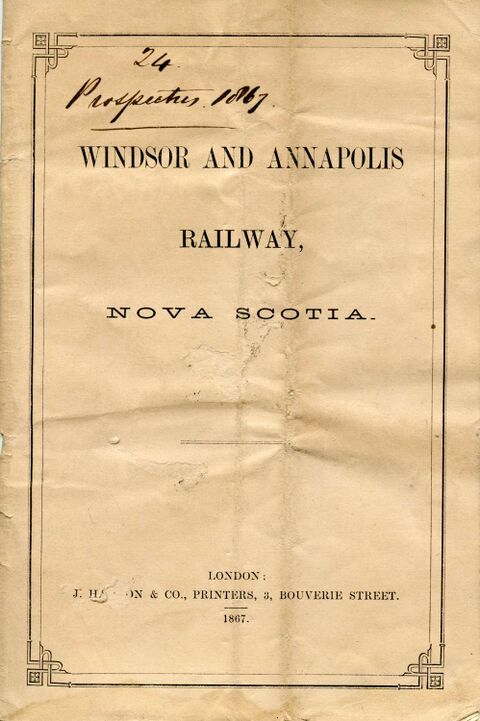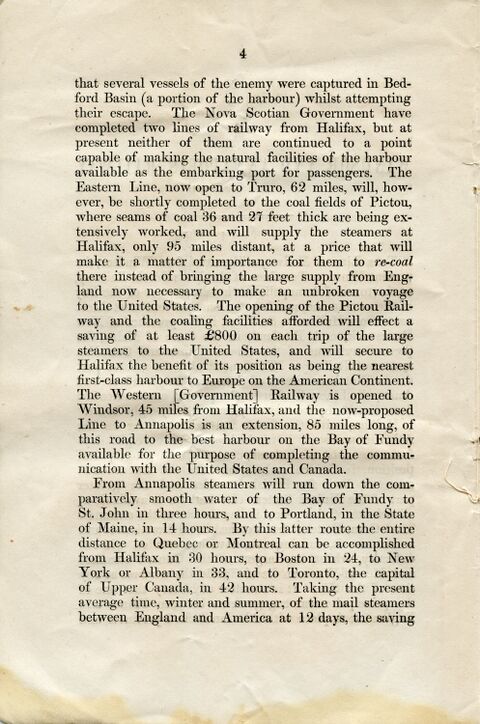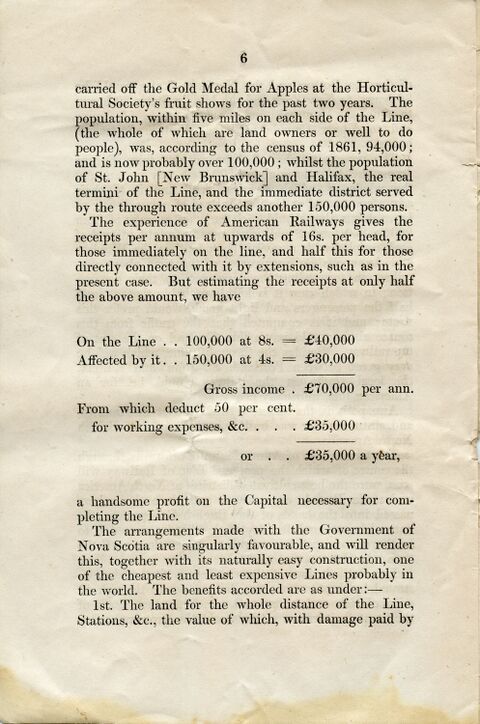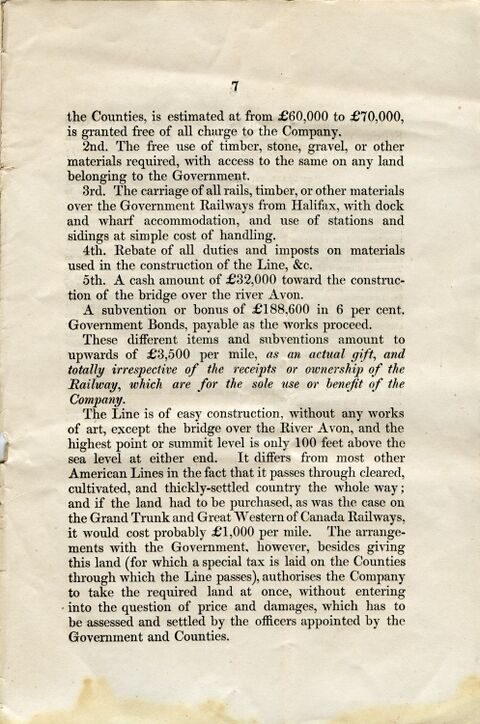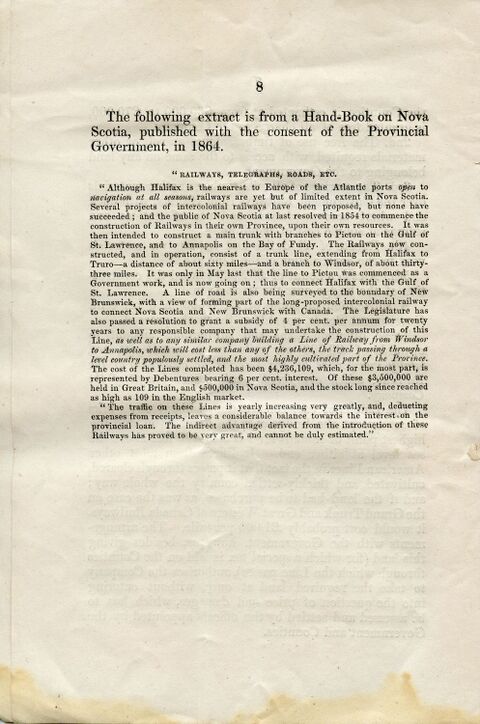Dominion Atlantic Railway Digital Preservation Initiative - Wiki
Use of this site is subject to our Terms & Conditions.
W&AR 1867 Prospectus
Windsor & Annapolis Railway 1867 Prospectus
Reference Tag
Please use this citation when referring to this article: Prospectus, WINDSOR AND ANNAPOLIS RAILWAY NOVA SCOTIA, London: J. Haddon & Co. Printers (1867), Copy No. 24 Comeau Family Collection
Prospectus
[The text of the Prospectus is shown here for search purposes, while images of the actual pages appear below, after the text.]
[Handwritten:] 24
[Handwritten:] Prospectus 1867
WINDSOR AND ANNAPOLIS
RAILWAY,
NOVA SCOTIA
LONDON:
J. HADDON & CO., PRINTERS, 3, BOUVERIE STREET.
1867.
WINDSOR AND ANNAPOLIS RAILWAY.
THIS Line of Railway will extend from Windsor, the present Western Terminus of the Nova Scotia Railway, to the town of Annapolis on the deep water of the Bay of the same name, making the shortest and most direct route from Halifax to St. John, in the province of New Brunswick, and Portland, in the State of Maine, the present terminus of the Grand Trunk and Canadian system of Railways. To Canada and the greater part of the Northern States of America the Windsor and Annapolis Line will shorten the present communication from Europe by from twenty-four to forty-eight hours.
Halifax, with the finest and best harbour on the Atlantic seaboard, is reached in seven or eight days from the coast of Ireland; and, from its geographical position, is the natural terminus of the transatlantic steamers, both for British America and the greater part of the United States. Its harbour is available at all seasons of the year; it has no bar at the entrance. The “Great Eastern” has steamed in all directions round and across it, turning round with steam on without difficulty, whilst the largest of the Cunard steamers and Men-of-War can lie alongside the wharves at any time of the tide. It is a matter of history that one of the principal naval engagements between France and England took place within its landlocked precincts, and that several vessels of the enemy were captured in Bedford Basin (a portion of the harbour) whilst attempting their escape. The Nova Scotian Government have completed two lines of railway from Halifax, but at present neither of them are continued to a point capable of making the natural facilities of the harbour available as the embarking port for passengers. The Eastern Line, now open to Truro, 62 miles, will, however, be shortly completed to the coal fields of Pictou, where seams of coal 36 and 27 feet thick are being extensively worked, and will supply the steamers at Halifax, only 95 miles distant, at a price that will make it a matter of importance for them to re-coal there instead of bringing the large supply from England now necessary to make an unbroken voyage to the United States. The opening of the Pictou Railway and the coaling facilities afforded will effect a saving of at least £800 on each trip of the large steamers to the United States, and will secure to Halifax the benefit of its position as being the nearest first-class harbour to Europe on the American Continent. The Western [Government] Railway is opened to Windsor, 45 miles from Halifax, and the now-proposed Line to Annapolis is an extension, 85 miles long, of this road to the best harbour on the Bay of Fundy available for the purpose of completing the communication with the United States and Canada.
From Annapolis steamers will run down the comparatively smooth water of the Bay of Fundy to St. John in three hours, and to Portland, in the State of Maine, in 14 hours. By this latter route the entire distance to Quebec or Montreal can be accomplished from Halifax in 30 hours, to Boston in 24, to New York or Albany in 33, and to Toronto, the capital of Upper Canada, in 42 hours. Taking the present average time, winter and summer, of the mail steamers between England and America at 12 days, the saving of time to Boston and the Northern States would be 36 hours, to New York and the Middle States 30 hours, to Quebec, Montreal, and Lower Canada 54 hours, and to Upper Canada and the Western States 48 hours.
The present number of steam voyages from Europe across the Atlantic is about 500 each way per annum, the whole of which steamers will find it to their advantage to coal at Halifax, instead of going direct; as by so doing, they would each carry an average of from 200 to 300 tons of additional paying freight instead of coal, coupled with a saving (by adopting the Windsor and Annapolis Railway route) of the time above described, in forwarding the passengers to their destination; in which case it is highly probable that at least half the passengers and light goods would prefer this route; and it is computed that the traffic from this source alone would pay a fair dividend on the cost of the railway. Besides the through traffic, which will be very great between Portland, St. John, and Halifax, the local traffic on the railway would be, for an American line, unusually heavy.
Annapolis is the oldest settled district in America, and, until Halifax was built, was the capital of British North America.
The two valleys of Annapolis and Cornwallis, through the centre of which the proposed Line of Railway will pass, were the best cultivated districts of North America under the French occupation; and since the colony passed into the hands of the English Government, the natural beauty and fertility of the district caused it to be the chosen spot for emigrants and settlers, until the entire district was occupied.
The fertile nature of these valleys is further demonstrated by the fact that the Railway passes through 40 miles of rich orchard ground, which produces some of the finest fruit grown in the world, the growers having
carried off the Gold Medal for Apples at the Horticultural Society’s fruit shows for the past two years. The population, within five miles on each side of the Line, (the whole of which are land owners or well to do people), was, according to the census of 1861, 94,000; and is now probably over 100,000 ; whilst the population of St. John [New Brunswick] and Halifax, the real termini of the Line, and the immediate district served by the through route exceeds another 150,000 persons.
The experience of American Railways gives the receipts per annum at upwards of 16s. per head, for those immediately on the line, and half this for those directly connected with it by extensions, such as in the present case. But estimating the receipts at only half the above amount, we have
On the Line . . 100,000 at 8s. = £40,000
Affected by it. . 150,000 at 4s. = £30,000
Gross income . £70,000 per ann.
From which deduct 50 per cent.
for working expenses, &c. . . . £35,000
or . . £35,000 a year,
a handsome profit on the Capital necessary for completing the Line.
The arrangements made with the Government of Nova Scotia are singularly favourable, and will render this, together with its naturally easy construction, one of the cheapest and least expensive Lines probably in the world. The benefits accorded are as under:—
1st. The land for the whole distance of the Line, Stations, &c., the value of which, with damage paid by the Counties, is estimated at from £60,000 to £70,000, is granted free of all charge to the Company.
2nd. The free use of timber, stone, gravel, or other materials required, with access to the same on any land belonging to the Government.
3rd. The carriage of all rails, timber, or other materials over the Government Railways from Halifax, with dock and wharf accommodation, and use of stations and sidings at simple cost of handling.
4th. Rebate of all duties and imposts on materials used in the construction of the Line, &c.
5th. A cash amount of £32,000 toward the construction of the bridge over the river Avon.
A subvention or bonus of £188,600 in 6 per cent. Government Bonds, payable as the works proceed.
These different items and subventions amount to upwards of £3,500 per mile, as an actual gift, and totally irrespective of the receipts or ownership of the Railway, which are for the sole use or benefit of the Company.
The Line is of easy construction, Without any Works of art, except the bridge over the River Avon, and the highest point or summit level is only 100 feet above the sea level at either end. It differs from most other American Lines in the fact that it passes through cleared, cultivated, and thickly-settled country the whole way; and if the land had to be purchased, as was the case on the Grand Trunk and Great Western of Canada Railways, it would cost probably £1,000 per mile. The arrangements with the Government. however, besides giving this land (for which a special tax is laid on the Counties through which the Line passes), authorises the Company to take the required land at once, without entering into the question of price and damages, which has to be assessed and settled by the officers appointed by the Government and Counties.
The following extract is from a Hand-Book on Nova Scotia, published with the consent of the Provincial Government, in 1864.
“ RAILWAYS, TELEGRAPHS, ROADS, ETC.
“ Although Halifax is the nearest to Europe of the Atlantic ports open to navigation at all seasons, railways are yet but of limited extent in Nova Scotia. Several projects of intercolonial railways have been proposed, but none have succeeded ; and the public of Nova Scotia at last resolved in 1854 to commence the construction of Railways in their own Province, upon their own resources. It was then intended to construct a main trunk with branches to Pictou on the Gulf of St. Lawrence, and to Annapolis on the Bay of Fundy. The Railways now constructed, and in operation, consist of a trunk line, extending from Halifax to Truro—a distance of about sixty miles—and a branch to Windsor, of about thirty-three miles. It was only in May last that the line to Pictou was commenced as a Government work, and is now going on; thus to connect Halifax with the Gulf of St. Lawrence. A line of road is also being surveyed to the boundary of New Brunswick, with a view of forming part of the long-proposed intercolonial railway to connect Nova Scotia and New Brunswick with Canada. The Legislature has also passed a resolution to grant a subsidy of 4 per cent. per annum for twenty years to any responsible company that may undertake the construction of this Line, as well as to any similar company building a Line of Railway from Windsor to Annapolis, which will cost less than any of the others, the track passing through a level country populously settled, and the most highly cultivated part of the Province. The cost of the Lines completed has been $4,236,109, which, for the most part, is represented by Debentures bearing 6 per cent. interest. Of these $3,500,000 are held in Great Britain, and $500,000 in Nova Scotia, and the stock long since reached as high as 109 in the English market.
“The traffic on these Lines is yearly increasing very greatly, and, deducting expenses from receipts, leaves a considerable balance towards the interest on the provincial loan. The indirect advantage derived from the introduction of these Railways has proved to be very great, and cannot be duly estimated.”
